Baja California Sur--La Paz to Puerto Escondido
and the Offshore Islands in the Gulf of California
April 16-24, 2005
by Roger Wolfe
Click on photos to see enlarged images.
We arrive via Aero California
to La Paz the morning of April 16, 2005. After checking into the infamous
Hotel Los Arcos located on the malecon beachfront we head for my favorite
restaurant in this charming city. Rancho Viejo serves Mexican barbecue
of the finest kind. We order up some arrachera-grilled flank steak
tacos and some cold cervezas. Ah, it's good to be back in Baja.
We see some birds on the hotel grounds such as COMMON GROUND DOVE,
NORTHERN MOCKINGBIRD, GILA WOODPECKER and the ubiquitous
HOUSE SPARROW and ROCK PIGEON. On the way to the restaurant
a COMMON RAVEN welcomes us to the peninsula. Over the nearby
harbor several MAGNIFICENT FRIGATEBIRDS soar like giant kites.
An OSPREY flies by with a fish in its talons.
We return to the hotel for a nice long siesta and a couple of complimentary
margaritas followed by a stroll down the malecon for dinner at Bismarckcito
where we have some excellent seafood. Almejas chocoletas naturel --
tasty, raw, chocolate clams and Camarones alla diabla -- Hot and spicy
prawns that we wash down with cold Coronas and lime. Now we're starting
to feel like we're on vacation!
We return to Los Arcos along the malecon seawall along the waterfront.
This is where you come to see and be seen in La Paz by foot or by
car. It's Friday night and there are a lot of people out and as usual
in La Paz everyone is friendly.
April 17
We have most of the day to ourselves before the others, who will be
joining us, arrive. I had ambitious plans to visit Sierra de San Antonio
for some of the montane endemic birds but somehow all my ambition
has drained away. I'm content to hang out in town and relax.
We stroll the malecon in the morning with the joggers, walker and
bikers. On the beach we see a smattering of shorebirds -- SPOTTED
SANDPIPER, WILLET, WHIMBREL and MARBLED GODWIT.
Larids seen are immature CALIFORNIA GULLS congregating on the
jetties with a few of the endemic YELLOW-FOOTED GULLS, a few
juvenile HEERMANN'S GULLS with a single ELEGANT TERN.
We also see herons -- GREAT BLUE and both SNOWY and
REDDISH EGRETS fishing in the shallows. A single BELTED
KINGFISHER is the only one we'll see down here.
Around 2 pm we head to the marina and board our home for the next
six days, the 85-foot motor vessel the Don Jose, which is operated
by Baja Expeditions and here we hook up with my co-leader, the excellent
Mexican naturalist Jose Sanchez.
By 5 pm the rest of our participants arrive on a shuttle from Los
Cabos. Half the people who went on this trip last year have returned
again this year. That says a lot for quality of the crew, the Don
Jose and the awesome sights of Baja California Sur.
For dinner we take a five minute walk back to Rancho Viejo where we
order a couple of kilos of arrachera and the rest of the fixings for
tacos and that's plenty for our group of 13. I'd eat all my meals
here if my wife would let me. On the way back to the boat we hear
our first CACTUS WREN. A BLACK-CROWNED NIGHT HERON on
one of the boat lines rounds out the bird list for the day.
We settle into our cabin for the night. It's good to back on board.
April 18
Our crew of six arrives early this the morning and we get underway.
As we leave the mainland behind and cross the channel to Isla Espiritu
Santo we start seeing seabirds -- both BROWN and BLUE-FOOTED
BOOBIES as well as a single flyby PINK-FOOTED SHEARWATER.
Passing the smaller islets of Gallina and Gallinero we spot a PEREGRINE
FALCON perched on the highest point.
Soon we arrive at the even smaller offshore islet of Los Islotes.
This islet may be small but it is packed with birds and sea lions.
We board the two skiffs or pangas, as they are known locally, and
circle Los Islotes. Over the pinnacle we see PURPLE MARTINS
and WHITE-THROATED SWIFTS. Lots of boobies and Yellow-footed
Gulls nest here. We also see BRANDT'S CORMORANT and foraging
on the rocks beside Sally Lightfoot Crabs are two BLACK TURNSTONES
and a single WANDERING TATTLER.
Back on the boat we don wetsuits, masks and snorkels and reboard the
pangas. This is the big attraction to Los Islotes; swimming with the
Sea Lions. Most of the males have departed so the smaller females
and pups are all that remain. Many tourists come here as the sea lions
are friendly. Recent DNA analysis has revealed a divergence in this
isolated population of sea lions. It is likely they will soon be recognized
as species separate from the California race and will be known as
the Sea of Cortez Sea Lion.
The sea lions swim circles and spirals around us. One is right in
my mask and I feel its whiskers on my own. I look over and another
is lying on Rick Allison's chest looking him in the eyes with her
big browns. It looks like love! I see another mouthing the heel of
Ray Wolfe's fin. All this sea lion activity makes it hard to snorkel
as I can't stop laughing at their antics. They are truly in their
element underwater.
From Los Islotes we do a few transects in search of whales. The conditions
are spectacular, what the skippers back home call greasy calm. We
start seeing many BLACK-STORM PETRELS flying about and from
the crow's nest I spot a XANTUS'S MURRELET. But the crowning
glory of the day comes when Jose spots a couple of dorsal fins logging
at the surface. We study the shape carefully and then we see more.
We even see the blunt heads briefly above water. We never see a blow
or a fluke; these animals just sink below the surface and quietly
disappear. I try like hell to get a photo but they're too far off.
These are the smallest of all the whales and are seen in dead calm
conditions only. It is a first for both Jose and me, these are DWARF
SPERM WHALES! Ten of them total. Later I will speak with a guide who
has worked down here for 15 years leading tours and he's never seen
one. We are extremely fortunate.
We anchor for the evening inside the caldera bay of Isla San Francisco
and take the pangas into shore for a short stroll. We inspect the
salt pans used by local fisherman and Jose introduces us to some of
the local flora. On the beach we are met by a pair of AMERICAN
OYSTERCATCHERS and two LEAST SANDPIPERS, and we also find
our first Zebra-tailed Lizard.
Last year we sought protection in this sheltered bay from a north
wind. Our day today was as calm as it could be but in the night the
infamous Corumel wind arrives from the Pacific, crosses the plains
between La Paz and Todos Santos and into the gulf. At 2:30 am things
get rocking. This bay is protected from the north winds but not from
the southwest. It makes for an interesting night's sleep.
April 20
We depart Isla San Francisco and as soon as we round the corner we
are out of the wind and in a short time we anchor off Isla San Jose.
After breakfast some of us board the pangas and others kayaks to explore
the mangrove estuary. The light wind is a plus here in keeping the
bugs at bay. This is the only place on our itinerary where we need
to be concerned about biting insects; no-see-ums or in espanol- jejenes.
As we motor into the estuary we hear the call of a CLAPPER RAIL
and soon thereafter we see and hear the first of many MANGROVE
WARBLERS. On the sandy bottom we see an aggregation of Upside
Down Jellies and along the edge of the mangrove roots we spot several
good sized Red Snappers. Jose trolls with a fly on a drop line and
ends up catching six of them which are then released.
Atop the mangroves we see three WHITE IBIS, a LITTLE BLUE
and a GREEN HERON and we also add EARED GREBE to our
trip list.
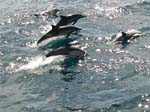 Back
aboard the Don Jose we set off in search of whales and seabirds. While
I'm taking a siesta Jose keeps watch and picks up a BLACK-VENTED
SHEARWATER and a RED-BILLED TROPICBIRD. As the day wears
on we come upon a pod of the Baja neritic form of LONG-BEAKED COMMON
DOLPHINS which are paler overall and show a pale gray triangle on
the dorsal fin. Everyone on board is up on the bow watching them ride
our wave.
Back
aboard the Don Jose we set off in search of whales and seabirds. While
I'm taking a siesta Jose keeps watch and picks up a BLACK-VENTED
SHEARWATER and a RED-BILLED TROPICBIRD. As the day wears
on we come upon a pod of the Baja neritic form of LONG-BEAKED COMMON
DOLPHINS which are paler overall and show a pale gray triangle on
the dorsal fin. Everyone on board is up on the bow watching them ride
our wave.
Motoring along we see some other interesting things go by such as
a Green Turtle and Hammerhead Shark and both Thornton's and Common
Manta Rays leaping clean out of the water.
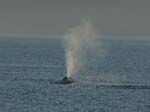 Jose
picks up the first big blow. Between Isla Catalan and the mainland
we find ten BLUE WHALES. Everyone on board is thrilled. One of them
looks thin; we can make out its spinal column under the flesh. On
its left side just behind the dorsal fin is a large bump.
Jose
picks up the first big blow. Between Isla Catalan and the mainland
we find ten BLUE WHALES. Everyone on board is thrilled. One of them
looks thin; we can make out its spinal column under the flesh. On
its left side just behind the dorsal fin is a large bump.
In the midst of all the excitement Jose calls out a BRYDE'S WHALE
but it is uncooperative and slips off without the rest of us seeing
it as they are known to do. We spend the night in the protected cove
of the tiny fishing village of Agua Verde.
April 21
Agua Verde is the location of some of the finest sunrises I've ever
laid eyes on. The sunsets on the Sea of Cortez are spectacular but
the sunrises are even finer. We board the pangas for a visit to the
village. As we pull onto the stony beach we see the local fishermen
cleaning their catch of sea cucumbers. This is a scene right out of
the Log from the Sea of Cortez where Steinbeck writes of this fishery
which is all shipped to Japan.
Walking through the village we see some new birds. This may possibly
be the HOODED ORIOLE capital of the world. They are ubiquitous
here among all the washingtonia and date palms. ASH-THROATED FLYCATCHERS
are also numerous and we get really nice looks at the endemic GRAY
THRASHER. On our walk we also see WHITE-CROWNED SPARROW,
BROWN-HEADED COWBIRD, PHAINOPEPLA, VIOLET-GREEN SWALLOW
and have excellent looks at both COSTA'S HUMMINGBIRD and BLUE-GRAY
GNATCATCHER. Mammal highlight is a BLACK-TAILED JACKRABBIT.
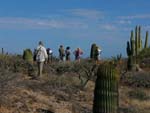 Back
aboard we search for whales between Isla Monserrat and Isla Catalan,
finding another pod of Long-beaked Common Dolphins and a Blue Whale
in the distance. We drop anchor at Isla Catalan, the most oceanic
of all the islands in the Gulf of California. This is home to many
endemic reptiles and plants. The snorkeling here at El Elephante,
a rock formation resembling the head of an elephant, is excellent;
we see a nice array of tangs, wrasses and parrotfish.
Back
aboard we search for whales between Isla Monserrat and Isla Catalan,
finding another pod of Long-beaked Common Dolphins and a Blue Whale
in the distance. We drop anchor at Isla Catalan, the most oceanic
of all the islands in the Gulf of California. This is home to many
endemic reptiles and plants. The snorkeling here at El Elephante,
a rock formation resembling the head of an elephant, is excellent;
we see a nice array of tangs, wrasses and parrotfish.
We take one of the pangas around the side of the island and hike back
to the Don Jose via an arroyo. Jose teaches us about the endemic plants
and we also manage to see two of the endemic reptiles -- a Santa Catalina
Side-blotched and Santa Catalina Whiptail Lizards. New birds seen
are LOGGERHEAD SHRIKE, BLACK-THROATED SPARROW and several
VERDIN. We are escorted during the course of our walk by a
pair of COMMON RAVENS which have developed quite a reputation
among the fishermen who camp on the island. The birds have become
very adept in finding ways to get into their food stores. Every time
the fishermen devise a way to keep the birds out they figure out a
way in.
We head back to the protected cove at Agua Verde for the night and
see 3 MURRELET sp. en route.
April 22
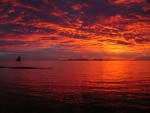 The
sunrise this morning at Agua Verde is perhaps the most spectacular
I've ever seen. After breakfast we head south along the coast to Santa
Marta. This is the property described by Bruce Berger in his book
on the Baja, Almost an Island. A caretaker family looks after
things and Baja Expeditions has a palapa here used by kayak groups.
Landing on the beach, we add two SEMIPLAMATED PLOVERS and our
only RED-TAILED HAWK to the trip list. We also observe a pair
of Turkey Vultures copulating atop a cardon cactus -- how romantic
is that?
The
sunrise this morning at Agua Verde is perhaps the most spectacular
I've ever seen. After breakfast we head south along the coast to Santa
Marta. This is the property described by Bruce Berger in his book
on the Baja, Almost an Island. A caretaker family looks after
things and Baja Expeditions has a palapa here used by kayak groups.
Landing on the beach, we add two SEMIPLAMATED PLOVERS and our
only RED-TAILED HAWK to the trip list. We also observe a pair
of Turkey Vultures copulating atop a cardon cactus -- how romantic
is that?
We visit the caretaker's family in whose garden we find an endemic
XANTUS' HUMMINGBIRD. A stroll through the nearby arroyo reveals
an interesting and diverse plant community. On the rocky beach we
also find a Side-blotched Lizard.
Snorkeling here is also outstanding, with sightings of Sea of Cortez
Angelfish and a Crown of Thorns.
From San Marta we proceed north in search of whales and seabirds all
the way up and around Isla Monserrat off Puerto Escondido. This is
as far north as we will go. Moving into blue water we come across
a second RED-BILLED TROPICBIRD and succeed in getting photos
of it.
We spend the bulk of the afternoon in search of cetaceans. In the
channel between Islas Monserrat and Catalan we find a large pod of
Long-beaked Common Dolphins with quite a few small youngsters among
them. We spend a good 20 minutes with this group and see lots of sexual
activity among them. Dolphins just want to have fun. A few pelagic
type BOTTLENOSE DOLPHINS put in a typical, brief appearance on the
bow wave.
Around happy hour we find more whales. Two of the localized population
of FIN WHALES are mixed in with a trio of blue whales which include
a mother and calf pair and the skinny whale we saw two days previously,
who we now dub "Bumpy" for the large bump and his left side. In this
same area Jose calls out a flyby POMARINE JAEGER and I pick
up a CRAVERI'S MURRELET lifting off the water. By the time
we're back in Agua Verde we are one bunch of tired enchiladas.
April 23
Leaving Agua Verde for the last time we head east toward Islas Santa
Cruz and San Diego. In passing these islands there are BLACK
and LEAST STORM-PETRELS in view almost continuously and it
is in this area that I spot two ASHY STORM-PETREL. This is
a surprise; these birds are thought to be endemic to the California
current on the Pacific coast so they are well out of their range.
We pass along the east side of Isla San Jose hoping to turn up some
Sperm Whales without success. We tie up at the Las Animas seamount
for some snorkeling and enjoy some excellent visibility. Looking down
we can see the rock face of Las Animas disappear into the depths.
Here we see some big groupers in the rock grottoes.
We come upon a feeding frenzy of Brown Boobies and pelagic type Bottlenose
Dolphins. After passing Isla San Jose two Pink-footed Shearwaters
soar by and 3 Murrelets on the water go unidentified to species.
We set anchor in a lovely little cove at Escondido Grande on Isla
Partida where we take a stroll in the evening.
April 24
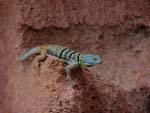
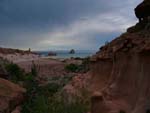 I'm
awakened at dawn by the song of a CANYON WREN. We leave early
for Espiritu Santo, separated from Partida by a mere 100-meter gap.
We drop anchor at Candelero and we hike up into the amphitheatre above
the beach. This is a lovely spot and here we find a San Lucan Rock
Lizard and back at the beach a Coachwhip Snake.
I'm
awakened at dawn by the song of a CANYON WREN. We leave early
for Espiritu Santo, separated from Partida by a mere 100-meter gap.
We drop anchor at Candelero and we hike up into the amphitheatre above
the beach. This is a lovely spot and here we find a San Lucan Rock
Lizard and back at the beach a Coachwhip Snake.
We enjoy some of the finest snorkeling on our trip. The water here
is alive with fish.
The short ride back to La Paz is with heavy hearts. We've had an excellent
time that none of us will soon forget.
Roger Wolfe for Monterey
Seabirds
